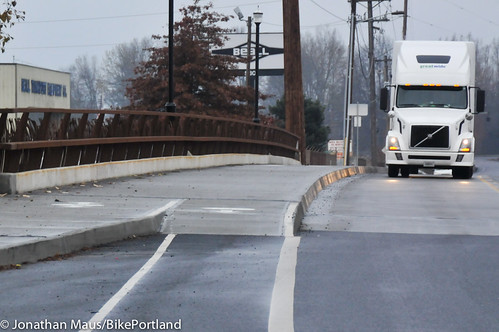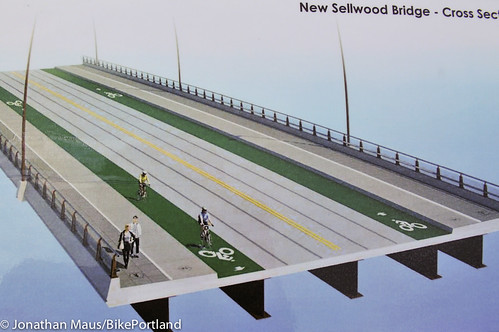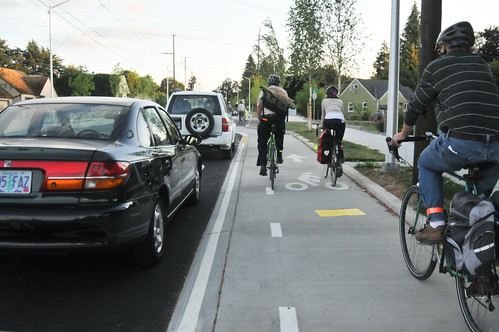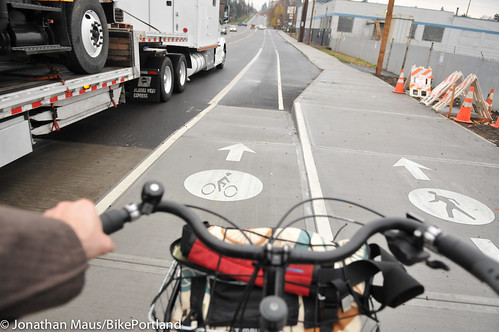
Have you noticed?
Something interesting is going on in transportation projects around Portland. There hasn’t been a press conference or an official decree about it; but it looks as though separated bicycling infrastructure is now just a standard procedure when new roads and bridges are built. This is a trend I’ve been following in the back of my mind for about a year now.
What follows are photos and brief notes/links on five recent projects where bicycles have their own dedicated space — physically separated from auto traffic. Taken all together, this move toward separated facilities definitely illustrates a larger trend that we can expect to see more of.
Portland-Milwaukie Light Rail Bridge

TriMet has already started building their PMLR Bridge over the Willamette River. When it opens in 2015 bike traffic will share a 14-foot wide path with other non-automotive bridge users.
SW Moody

Similar to Cully Blvd, this is another example where PBOT had a clean slate to work with and they decided to build out a world-class bikeway. For more images and thoughts, see my photo essay from back in November.
Sellwood Bridge

This project just got underway last week and it’s the latest to show how separated bikeways are now “baked in” to major bridge projects. Kudos to the citizen volunteers and Multnomah County officials who came up with this cross-section.
Cully Blvd

For PBOT traffic engineers and planners, this was a dream project. They got to completely re-do an entire roadway, which isn’t an opportunity that comes along very often. The result was Portland’s first major cycle track that begins to mimic designs seen in Europe.
Vancouver Avenue Bridge


This project hasn’t gotten nearly as much attention as the others, but it deserves a second look. The bridge is a key connection between North Portland, Hayden Island and the City of Vancouver. When it was recently rebuilt due to a fire that damaged its supports, engineers ended up directing the bike lane up onto a shared sidewalk. This happened without much of a peep at all from PBOT (I didn’t even fully understand the design until riding it myself yesterday evening.)
Taken together, these projects are important on many levels. Most road users — on both sides of the windshield — appreciate the lower-stress environment produced when bikes and cars are not sharing the same space. The projects also give us a taste of what’s possible. While they are all just small pieces of roadway, they plant the seed of what could be. Hopefully, they’ll make people start to think: “Why can’t I enjoy this type of experience for my entire trip?”
While PBOT, TriMet, and Multnomah County deserve kudos for these signs of progress, the real challenge will be in making these type of facilities the norm and not the exception; and figuring out a way to retrofit existing cross-sections to include more separation (the over two year “pilot project” of the SW Broadway cycle track — which is yet to get any major expansions or improvements — is a good example of this challenge).
So, is separation really the new standard? I asked Mayor Sam Adams’ Transportation Director Catherine Ciarlo. She stopped short of saying that separated bike facilities will be in every future road project; but she did say that the City is looking for ways to achieve separation whenever possible:
“I’d say separation is the gold standard. But at the moment we’re in an economy struggling for bronze. So the challenge is to figure out how to achieve separation in creative or economical ways. An example: Neighborhood Greenways create “separation” by making the environment more desirable for bikes and walking and less conducive to driving. Another example: upgrading signal efficiency at the 12th Avenue Overcrossing allowed us to “find” more right of way and allow for a higher degree of separation.”

